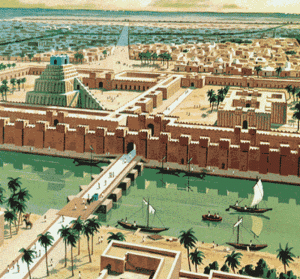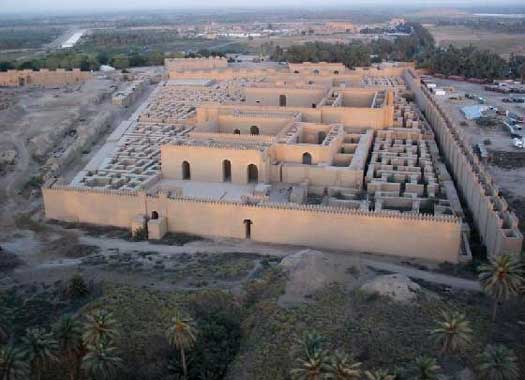When it comes to the prosperity of a country, many people often think of lavish castles, lands rich in natural resources such as forests, mines and warm weather…
But not for Babylon, the richest kingdom of antiquity! The kingdom of Babylon was located on the edge of the Euphrates, in a flat valley, but arid and dry. It does not have forests, mines, rocks for the construction of military or civilian structures, nor on a favorable trade route.
Babylon is an outstanding example of the human capacity to achieve great goals, using all the means at his disposal. The development of this vast city was built entirely by human hands. All its wealth is attributed to its people.
Babylon has only one unique advantage: the soil is quite fertile because the Euphrates carries a lot of alluvium every year. But to take advantage of this privilege, the engineers of ancient Babylon had to research and execute the greatest project of its time. It is the construction of dams and a myriad of small canals to carry water from the main river to the villages, turning arid lands into beautiful farmland. As a result, the Babylonians can cultivate, cultivate and reproduce, and have a prosperous and wealthy life in their homeland. It is one of the first large-scale constructions known in the history of mankind.
Fortunately, in its long existence Babylon did not produce greedy kings eager to conquer the whole world. When Babylon was at war, most were wars of self-defense against ambitious enemies in other countries drawn to Babylon’s treasures, gold, and jewelry that invaded them.
Five thousand years later, although Babylon is gone, it has become a myth that attracts everyone’s understanding. Today, the remaining Babylonian citadel remains in Asia, about six hundred miles east of the Suez Canal, north of the Persian Gulf. It is located about 30 degrees longitude, above the equator, has a hot and dry climate. The temple citadels are gone, leaving only the crumbling and silent ruins.
In the past the Euphrates Valley was an agricultural land with very large-scale irrigation systems, densely populated, and now it has become a barren wasteland, dotted with barren bushes, Weeds face the wind and sand to survive. The ancient elephant cemeteries as well as the long caravans of Babylonian merchants are equally legendary. Today in this land we sometimes come across groups of nomadic Arabs who struggle to maintain their miserable lives by raising small herds of cattle.
However, the centuries have passed, the nomads, the travelers passing through this land do not see anything strange and do not know that, under this land hides traces of a glorious time. Until geologists picked up many pieces of pottery and broken bricks exposed by the rain that had eroded the rock. After that, European and American expeditions began to rush to rummage and search. And luckily they discovered the remains of ancient Babylon.
Babylon is one of the ancient kingdoms built of earth and brick, over a period of thousands of years the walls of the sun and wind oil disintegrated and returned to the sandy soil. Had it not been for the discovery and careful excavation by archaeologists, we would never have known the great works, the magnificent ancient palaces of Babylon that were buried. for centuries.
Many scientists considered the Babylonian civilization and the other towns in the Euphrates Valley to be the oldest. Based on unearthed artefacts, including pieces of burnt clay depicting an eclipse that the ancient Babylonians witnessed, modern astronomers have been able to date and confirm. Babylonian civilization dates back approximately 8,000 years to our time.
From antiquities we can know that 8,000 years ago the Sumerians lived in Babylon. They resided in a territory surrounded by walls. Scientists can only assume that Babylon must have been through a very long time before these remarkable achievements were achieved. During this period, they knew how to build solid walls to protect the country, and a large-scale irrigation system to facilitate plowing and cultivation. In addition, the Babylonians also have an educational system with creative people eager to learn. The remaining evidence shows that Babylon was the birthplace of the first engineers, the first astronomers, the first mathematicians, the first financiers, and the first to write.
Scientists are very interested in the canal system of the ancient Babylonians. He transformed the arid valley into fertile agricultural land. According to the remains left, scientists say, the canals and ditches are very large, more than ten horses can cross the canal. In terms of size, they can be compared to the larger canals in Colorado and Utah today.
excavation of ancient Babylon. In addition to constructing irrigation works to bring water to the interior lands of the valley, Babylonian engineers completed another equally important project. It is a complex and efficient water drainage system. With this system, they drained vast swamps near the Euphrates and Tigris to make them fertile growing areas. Babylon in the movie Alexander the Great
Herodotus, the Greek astronaut and historian, once visited Babylon. His notes are a great help to us in understanding the strange customs, the characteristics of the fertile soils and the fertile cultures of the inhabitants.
The Babylonian glory is no more now, but their knowledge is still valid to this day. This knowledge is stored in hundreds of thousands of baked clay tokens that archaeologists find – safely buried in sandy soil. At that time, writing paper was not yet available, the Babylonians carefully engraved their knowledge on damp clay tablets. Then they cooked and preserved. These clay cards are approximately 15cm x 20cm, 2cm to 3cm thick. The content engraved on it is very diverse, including stories, poems, history, decrees of justice, laws of the land, land titles, promises of debt repayment, letters written to send to neighboring kingdoms …
In addition to the irrigation works, Babylon has an exceptional achievement which is often mentioned. It is the construction of the vast wall surrounding the kingdom. Its construction scale is comparable to that of the great pyramids of Egypt. For this work, Queen Semiramis is considered the first. Modern archaeologists have not yet found traces of the original walls, but according to the data of excavated artifacts, they are about 15-18 meters high, the outer surface is covered with baked bricks. protected on the outside by a deep trench.
Later, about six hundred years BC, King Nabopolassar rebuilt Babylon on a massive scale. However, King Nabopolassar died before he saw the finished work. King Nebuchadnezzar ascended the throne and continued his father’s unfinished work.
When finished, the height and length of the wall made a lot of people amazing. According to recorded data, they were around 48 meters high, equivalent to the height of a 15-story building today. Its total length is estimated between 14,400 and 17,600 meters approximately. The wall was very wide, enough for six horses to pass through it. Later, during the conquest of the kingdom of Babylon, the Arabs destroyed it by removing bricks and tiles to build temples, palaces, houses and other structures. This massive city wall is nothing more than traces of the foundations and moats.
The kingdom of Babylon was organized in a fairly modern and coherent system. In the city there are fixed streets, streets and department stores. Retailers sell merchandise everywhere. The religion is honored by magnificent and magnificent temples. Located in the middle of the kingdom is a royal castle made up of royal castles. The citadel wall surrounding the citadel was often higher than the kingdom wall.
In terms of art, the Babylonians made great achievements in the fields of architecture, painting, weaving, embroidery, gold and silver making, metal weapon making. and tools for agriculture. Jewelers have created very beautiful and sophisticated jewelry. Today, the world’s most famous museums display many antiques discovered in the graves of wealthy Babylonian citizens.
Around 8,000 years ago, when other groups of ancient people around the world lived only in caves, cut trees with primitive axes, hunted animals with arrows attached to a sharp or struck piece of rock. Each other with the help of sticks, the ancient Babylonians began to know how to build castles, citadels; using iron and steel axes, spears and arrows with a copper tip.
The Babylonians are experienced financiers and merchants. Researched documents indicate that they were the first to know how to use gold and silver as a medium of exchange, to use debit cards or to register their property.
Since about 540 BC, no invading army has captured Babylon. Babylon has remained strong against all military power. Later, the cause of the fall of Babylon was very strange and quite mysterious. At this time, Cyrus, one of the kings with the ambition to conquer the neighboring kingdoms, expressed his intention to invade Babylon. The advisers of King Nabonidus who ruled Babylon at that time were convinced that, rather than wait for Cyrus’ army to come and besiege the city, it was better to go to war. Nabonidus didn’t think carefully, so he went to the army. As a result, Babylon’s troops continued to fail. Nabonidus had to abandon the city and flee the kingdom. So Cyrus took Babylon without any resistance.
Since then, Babylon’s strength and popularity has also waned. Over time it became desert, calm and now only a desert land full of sand and wind. Once again Babylon returns to the land where she was born. The greatness, the greatness and the greatness of Babylon are only a myth …
It can be said that the majestic citadels of Babylon and the majestic temples and palaces have turned to dust, but the knowledge, the wise experiences and the exceptional achievements of this ancient kingdom remain. circulated so far. Perhaps, although she was dubbed the inviolable before the enemy, but Babylon City still could not avoid the law of the birth and death of time. Regardless, the Babylonian civilization became an important mark of great human progress in later eras.




